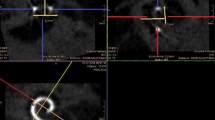Abstract
In order to improve cochlear implant surgery in patients with obstructed round windows, surgical orientations of the round window and scala tympani relative to the stapes footplate were examined in ten normal temporal bones using a computer-aided, three-dimensional reconstruction and measurement technique. The round window was found to be exactly inferior to the midpoint of the inferior margin of the stapes footplate in most cases. An optimal point on the promontory wall for drilling to reach the bottom of the scala tympani of the basal turn was found to lie approximately 1.5 mm anterolateral or anterolateral inferior to a point 3 mm inferior to the midpoint of the inferior margin of the stapes footplate. A combination of the transmeatal and facial recess approaches made it possible to consistently reach the scala tympani, and demonstrated that this approach was also applicable to patients with obstructed round windows.
Similar content being viewed by others
References
House WF (1982) Surgical considerations in cochlear implantation. Ann Otol Rhinol Laryngol 91 [Suppl 91]:15–20
Luxford WM, House WF (1987) House 3M cochlear implant: surgical considerations. Ann Otol Rhinol Laryngol 96 [Suppl 128]:12–14
O'Donoghue GM, Jàckler RK, Jenkins WM, Schindler RA (1986) Cochlear implantation in children: the problem of head growth. Otolaryngol Head Neck Surg 94:78–81
Sando I, Doyle WJ, Okuno H, Takahara T, Kitajiri M, Coury WJ III (1986) A method for the histological analysis of the temporal bone and the eustachian tube and its accessory structures. Ann Otol Rhinol Laryngol 95:267–274
Sataloff RT (1991) Embryology and anomalies of the facial nerve and their surgical implications. Raven Press, New York
Takagi A, Sando I (1988) Computer-aided three-dimensional reconstruction and measurement of the vestibular end-organs. Otolaryngol Head Neck Surg 98:195–202
Takagi A, Sando I (1989) Computer-aided three-dimensional reconstruction: a method of measuring temporal bone structures, including the length of the cochlea. Ann Otol Rhinol Laryngol 98:515–522
Takahashi H, Sando I (1990) Computer-aided 3-D temporal bone anatomy for cochlear implant surgery. Laryngoscope 100: 417–421
Takahashi H, Takagi A, Sando I (1989) Computer-aided threedimensional reconstruction and measurements of the ro`und window and its membrane. Otolaryngol Head Neck Surg 101:517–521
Takahashi H, Sando I, Takagi A (1989) Computer-aided threedimensional reconstruction and measurement of the round window niche. Laryngoscope 99:505–509
Takahashi H, Sando I, Takagi A (1990) Computer-aided threedimensional reconstruction and measurement for multiple-electrode cochlear implant. Laryngoscope 100:1319–1322
Author information
Authors and Affiliations
Rights and permissions
About this article
Cite this article
Takahashi, H., Honjo, I., Sando, I. et al. Orientation for cochlear implant surgery in cases with round window obstruction: a computer reconstruction study. Eur Arch Otorhinolaryngol 252, 102–105 (1995). https://doi.org/10.1007/BF00168029
Received:
Accepted:
Issue Date:
DOI: https://doi.org/10.1007/BF00168029




